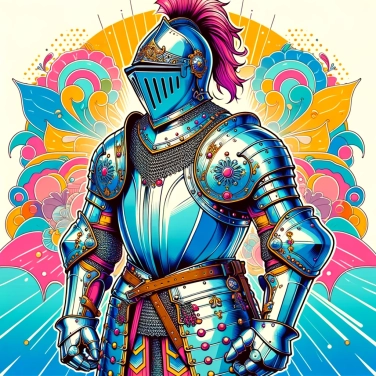The knights wore heavy armor to protect themselves from weapons and projectiles during battles, as well as to symbolize their social status and military power.

In the Middle Ages, war was harsh and violent, so solid protection was necessary to survive fierce attacks. The weapons of the time, such as the long sword, axe, or mace, could easily inflict serious, even fatal injuries. Wearing heavy armor offered the best chance of survival against these powerful blows, as it absorbed shocks and prevented sharp weapons from penetrating. A sturdy armor also allowed for charging directly at the enemy without too much hesitation, providing the knight with a certain level of security in action. The high weight mainly came from the need for reinforced protection on vital points: chest, head, shoulders, and joints that were particularly vulnerable during close combat. Even though the armor seemed imposing and uncomfortable, it was clearly vital: it was better to endure reduced mobility than risk losing a leg or even one's life at the slightest serious attack.
In the Middle Ages, a heavy and imposing armor was a true visual signal clearly displaying the wealth and power of the knight who wore it. The more complex, decorated, and massive the armor was, the more it showcased the high social status of the warrior. Having custom armor adorned with engravings, emblems, or even gilded was reserved for the wealthiest, such as nobles or powerful lords, thereby asserting their economic and social dominance in front of everyone. It also served to impress enemies even before combat began: a knight with magnificent and imposing armor instilled fear, and it was a genuine psychological tactic. This demonstration of strength and opulence often continued off the battlefield, during tournaments or official ceremonies, where the prestigious and heavy appearance of the knights carried as much symbolic weight as practical significance.
Medieval combat techniques partly explain why armor was so heavy. In the Middle Ages, the cavalry charge, particularly during tournaments or pitched battles, required significant protection against lances, swords, and clubs. Therefore, the more powerful the blows and the heavier the weapons, the more the armor needed to withstand. Another important point is the gradual rise of foot combat. Here, one had to be able to resist slashing strikes, but also thrusts (attacks with the tip of a blade to pierce). As a result, to withstand aggressive techniques aimed at perforation, armorers added reinforced and thick plates. One last thing to know: knights often fought in close combat, in melee. It was impossible to keep an eye on the entire battlefield; a heavy armor was sometimes the only solution to avoid unpleasant surprises in the chaos of close-range fighting.
Initially, the first armors were mostly made of chain mail: practical but not really armored against every blow. Then, throughout the 14th century, plate armor began to emerge: rigid metal plates covering almost the entire body. It was genuinely solid. As we approach the Renaissance, armorers perfected techniques to make these armors increasingly fitted and mobile despite their heavy weight. Thanks to metallurgical advancements, such as the technique of quenching that reinforces steel, armors became strong without necessarily becoming heavier. Finally, towards the end of the Middle Ages, the development of firearms led knights to seek thicker armor to attempt (not always effectively, by the way) to stop bullets. After that, heavy armor gradually fell into disuse as it became less useful against these new, powerful weapons.
A full suit of armor from the 15th century generally weighed between 20 and 30 kilograms, which is approximately the weight of the modern equipment worn by today's infantry soldiers.
Despite their weight, heavy armor was designed with great care to effectively distribute mass across the entire body, allowing knights to move, ride horses, and even get back up quickly after a fall.
Some armors were so precious and expensive that they were passed down from father to son over several generations, representing both heirlooms and tools of war.
There were medieval tournaments where participants specifically wore heavy and reinforced armor, which was heavier than that used in real combat, to better withstand the violent impacts of jousts.
Although leather is lighter, it offered much less protection against sword strikes, arrows, or crossbow bolts. The forged steel of heavy armor provided optimized safety against the threats of the battlefield, despite the significant weight difference.
Training to wear armor often began around the age of 14, when the young noble became a squire. Apprentice knights gradually accustomed themselves to the weight of the armor through rigorous physical exercises and specific training aimed at developing strength and endurance.
No, medieval armor was ingeniously articulated with movable plates and hinges, allowing knights to retain most of their movements. Although it could slightly limit certain actions, this armor was not as restrictive or cumbersome as often suggested by films or popular literature.
No, knights primarily wore their armor during battles, tournaments, or important ceremonies. Outside of these circumstances, they generally preferred lighter and more comfortable clothing for everyday tasks and less risky situations.
The dressing could take between 15 and 30 minutes with the help of a squire or a servant trained for this task. Each piece had to be carefully fitted and secured to ensure optimal protection and to avoid any discomfort for the knight.
A full suit of knight's armor typically weighed between 20 and 30 kg, evenly distributed over the body to allow for good mobility and endurance in battle. Contrary to popular belief, knights were still capable of riding horses, running, or getting up quickly after a fall.

No one has answered this quiz yet, be the first!' :-)
Question 1/5